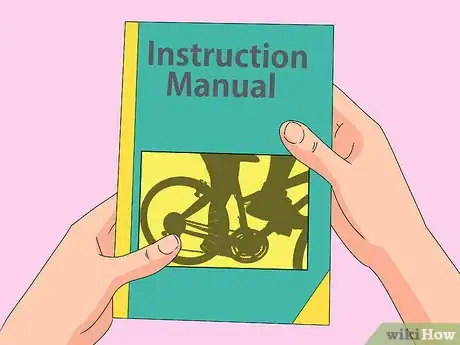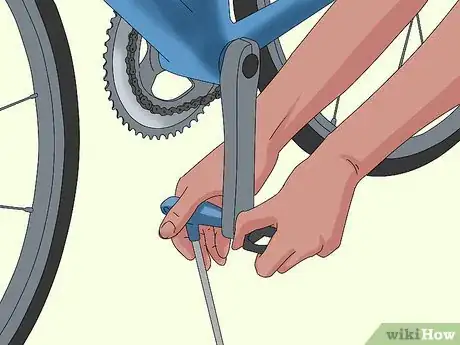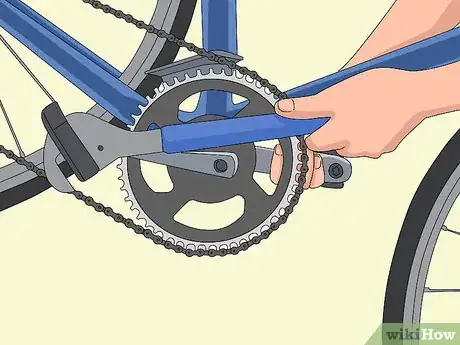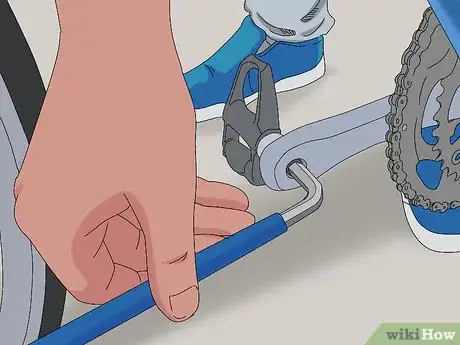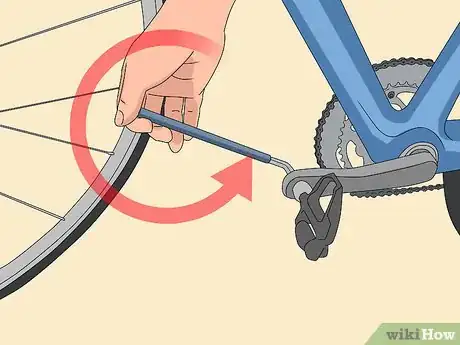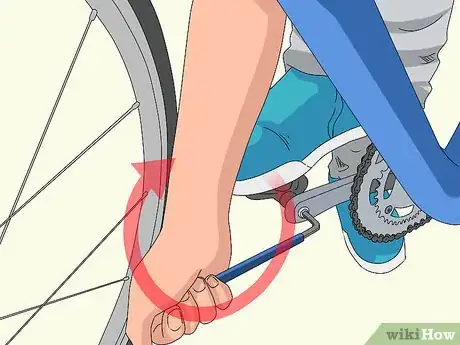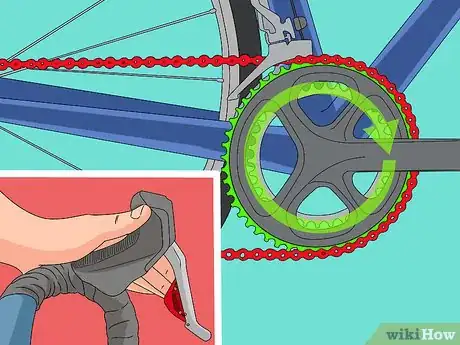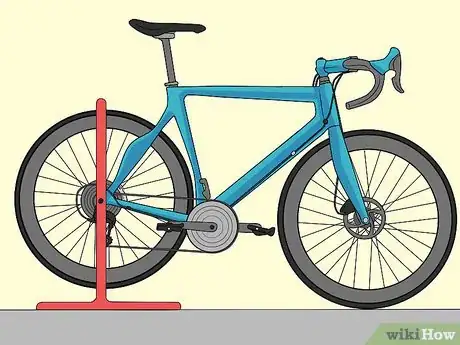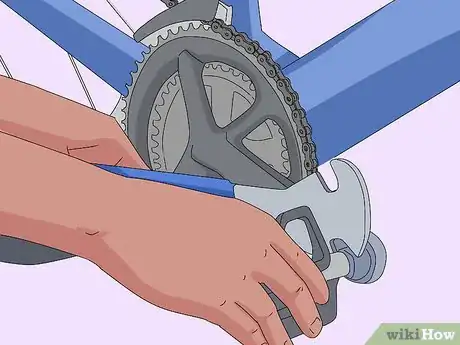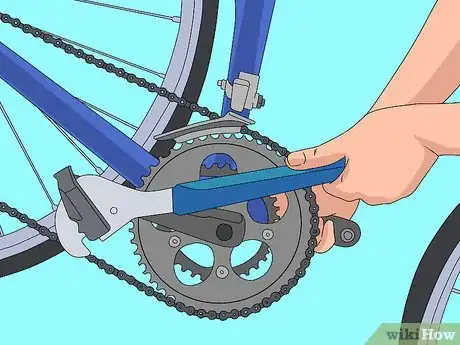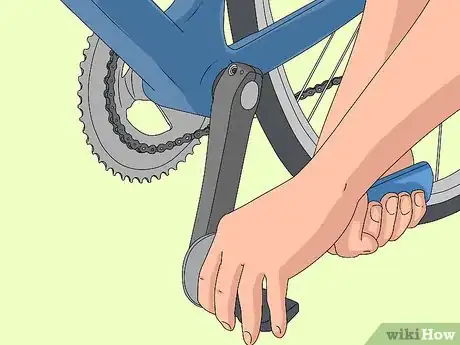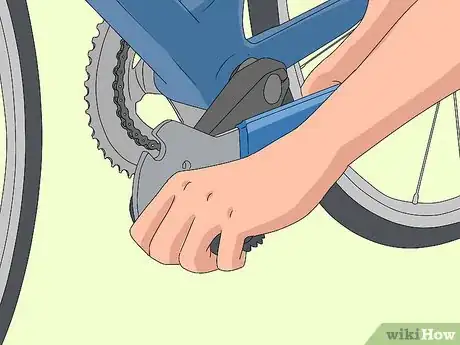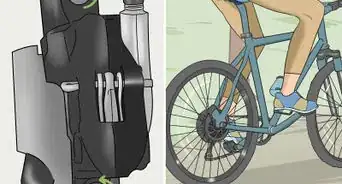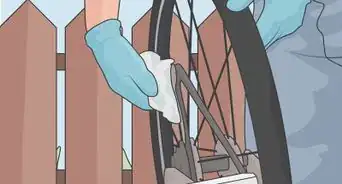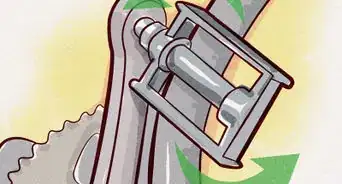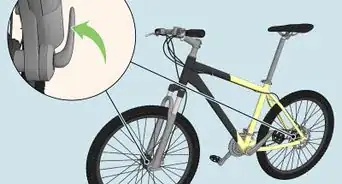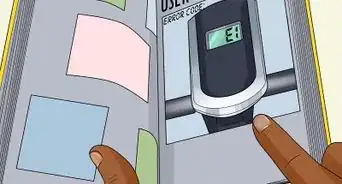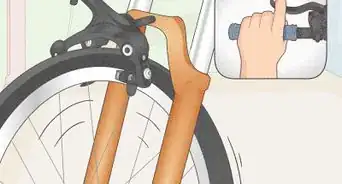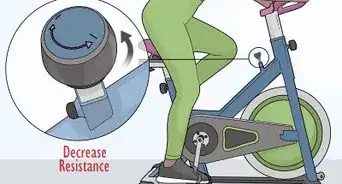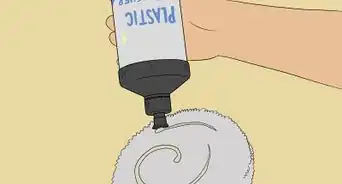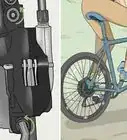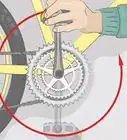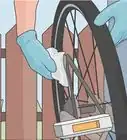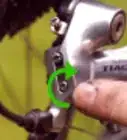This article was co-authored by Jonas Jackel. Jonas Jackel is the Owner of Huckleberry Bicycles, a bicycle retail store based in San Francisco, California. Jonas has over 20 years of experience managing bicycle retail stores and has operated Huckleberry Bicycles since 2011. Huckleberry Bicycles specializes in servicing, repairing, and custom building road, cross, gravel, touring, folding, and e-bikes. Jonas was also previously sat on the Board of Directors for Bike East Bay, a bicycle-advocacy non-profit organization based in Oakland, California.
There are 9 references cited in this article, which can be found at the bottom of the page.
This article has been viewed 47,641 times.
If you want to upgrade or replace your pedals, you'll need to take them off first. Doing so is fairly simple as long as you know what kind of pedals you have. First, you'll have to figure out whether you need a hex key or 15mm wrench to remove the pedals. Then, it's as simple as unscrewing the pedal with the right tool so that it detaches from the crank.
Steps
Determining Which Tools You Need
-
1Read the bike's instruction manual if it came with one. If your bike came with an instruction or maintenance manual, it will usually have pedal removal and installation instructions. Read these thoroughly to see if there is anything particular that you need to do with your specific bike. The instructions will also detail whether you need a 15mm wrench or a hex key to remove the pedals.[1]
- Check to see if the manual has a table of contents so that you can skip to the pedal or crank section.
- If your bike didn't come with a manual, you can still determine what kind of tools you'll need to remove them.
-
2Look for a hex fitting on the pedal if you don't have a manual. The pedal is attached to the crank by the crank arm. The hex fitting will be located on the end of the crank arm and looks like a hexagonal impression. Most bike pedals require either a 6mm or 8mm hex key to install and remove the pedals.[2]
- Popular crank brands that require a hex key include Shimano, Look, and Speedplay.
Advertisement -
3Get a 15mm wrench if the pedals don't have a hex fitting. Most basic or flat pedals require a 15mm wrench rather than a hex key. You can purchase a 15mm pedal spanner, which is specifically used for bike repairs, or you can use a standard 15mm wrench to remove your pedals.[3]
Taking the Pedals off with a Hex Key
-
1Fit a 6mm and 8mm hex key into the fitting to see which one you need. If you're unsure of which sized hex key you need, figure it out by inserting both a 6mm and 8mm hex key into the hex fitting on the end of the crank arm. The hex key should fit snugly in the fitting and allow you to rotate the bolt that holds the pedal in place.
-
2Rotate the hex key clockwise in the left pedal to loosen the pedal. Insert the appropriately sized key into the hex fitting. Rotate the hex key clockwise while holding the pedal in place to loosen it. Continue rotating the hex key until the pedal comes loose.[4]
- The left pedal is sometimes marked with an “L.”
- Rotating the crank so that the pedal is in a downward position may make it easier to remove it.
-
3Loosen the right pedal by turning the hex key counterclockwise. Go over to the other side of the bike and fit the hex key into the fitting on the end of the crank arm. Usually, the right pedal is on the same side as your chainrings. Turn the key counterclockwise to loosen the pedal. Then, continue turning the hex key until the pedal comes loose enough to take off the crank.[5]
- The right pedal will be on the same side as the chainring and is sometimes marked with an “R.”
Removing Pedals with a 15mm Wrench
-
1Set the bike to a high gear to shift the chain to the biggest ring. Once you set the bike to a high gear, rotate the pedals a few times so that the chain shifts to the largest ring. This will give you more room and will make it easier to remove the pedals.[6]
- If your bike doesn't have different gears, skip this step.
-
2Lift up the back wheel on the bike. Hang your bike from a bike rack or you can hang the saddle on the edge of a table or workbench while you remove the pedals. Lifting up the back wheel as you work will keep the bike still even if you pedal the bike forward or rotate the crank. This will make removing the pedals with a wrench much easier.[7]
-
3Position a 15mm wrench between the right pedal and crank arm. The right pedal will be on the same side as your chainring. The pedal is attached to the bike's crank with a 2–3 in (5.1–7.6 cm) crank arm. Fit the 15mm wrench around the fitting where the pedal and crank arm are connected.[8]
- Rotate the pedals in a slightly forward position to make rotating the wrench easier.
-
4Pull up on the wrench to loosen the pedal. Once the crank arm is in place, pull up on the handle to loosen the bolt connecting the pedal to the crank arm. The pedal will start unthreading from the crank arm when you rotate the wrench counterclockwise. You should feel the pedal come loose after a single rotation with the wrench.[9]
-
5Hold the pedal and rotate the crank forward to remove it. Push on the pedals so that you rotate the crank as if you were riding the bike. Hold the pedal and wrench in place and continue pedaling the bike forward until the pedal comes completely off.[10]
-
6Turn the wrench clockwise on the left pedal to remove it. Go over to the other side of the bike and repeat the process to remove the non-drive (left) pedal of the bike. Pull up on the wrench to loosen the bolt. Then, hold the pedal in place so that it doesn't rotate as you pedal the bike forward to completely unscrew the left pedal.
- Kids should learn how to balance, master handlebars, steering, and balancing on two wheels before learning how to pedal.[11]
- If the kid's a little older, you can take the pedals off their bike and let them walk around with it.[12]
- Let them run around with it until they learn to balance, then put the pedals back on.[13]
Things You'll Need
- 6mm or 8mm hex key
- 15mm wrench
References
- ↑ https://youtu.be/LFbSBG7jMzY?t=1m5s
- ↑ https://www.parktool.com/blog/repair-help/pedal-installation-and-removal
- ↑ https://www.parktool.com/blog/repair-help/pedal-installation-and-removal
- ↑ https://youtu.be/YmPkYMPVqQU?t=1m19s
- ↑ https://youtu.be/YmPkYMPVqQU?t=1m45s
- ↑ https://youtu.be/LFbSBG7jMzY?t=1m24s
- ↑ https://youtu.be/8LLiJF50Zfk?t=1m4s
- ↑ https://www.parktool.com/blog/repair-help/pedal-installation-and-removal
- ↑ https://youtu.be/YmPkYMPVqQU?t=4m27s
